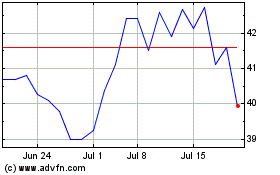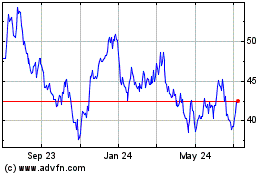STMicroelectronics Launches World's First Multi-Band GNSS Receiver with Autonomous-Driving Precision and Automotive Safety Co...
February 27 2018 - 9:01AM

- ST's new Teseo receiver combines multiple-frequency (L1, L2,
and L5) and multi-constellation tracking to correct positioning
error for high-precision navigation
- First-in-class device features built-in integrity checking for
use in safety-critical systems (ISO 26262 ASIL)
- Enables autonomous-driving systems to combine precise
positioning with sensor data for enhanced system performance,
safety, reliability
Geneva, February 27, 2018 - Assisting safer autonomous
driving, STMicroelectronics (NYSE: STM), a global semiconductor
leader serving customers across the spectrum of electronics
applications, has introduced the world's first multi-frequency
satellite-navigation receiver chipset suitable for safety-critical
automotive applications and high accuracy positioning at the
decimeter and centimeter-level for PPP and RTK applications.
Traditional in-car navigation systems help drivers reach their
destinations using receivers and commercial satellite services that
allow positioning accurate to within a few meters. With increasing
use of autonomous systems such as lane-departure warning (LDW),
adaptive cruise control (ACC), valet parking, and auto-pilot,
greater accuracy is needed to ensure safety and reliability, in
combination with proximity sensors such as cameras, radar, lidar,
and others, to monitor the driving environment automatically. Fully
self-driving vehicles of the future will also demand high-accuracy
positioning.
By tracking satellites of all GNSS (Global Navigation Satellite
System) constellations[1] simultaneously on at least two of the
frequencies used by each system (instead of one in other products),
ST's automotive-quality Teseo APP (Automotive Precise Positioning)
receiver provides high-quality raw GNSS data for PPP (Precise Point
Positioning) and RTK (Real Time Kinematic) algorithm, which allows
accurate positioning and rapid convergence time worldwide.
In addition to its high accuracy, the industry-unique receiver
monitors the integrity of the satellite data to alert the system if
accuracy is degraded for any reason. This permits Tier-1
manufacturers to certify safety-critical systems in accordance with
the automotive industry functional-safety standard, ISO 26262, up
to the highest Automotive Safety Integrity Level (ASIL). Teseo APP
also integrates a secure microcontroller for secure system boot and
data-output authentication to keep sensitive data safe from
attack.
Launched alongside Teseo APP, ST's Teseo V chip provides
equivalent multi-frequency precise positioning in a simplified
device for non-safety-critical applications where integrity
assurance is not required.
"High-accuracy satellite positioning makes autonomous driving
safer, smoother, and more reliable," said Antonio Radaelli,
Director, Infotainment Business Unit, STMicroelectronics. "Our
newest Teseo APP GNSS chip combines extreme accuracy and precision
with industry-unique integrity assurance for use in safety-critical
applications."
ST is now supplying product samples to lead customers who are
developing autonomous-driving systems expected to appear first in
high-end vehicles launched in 2020/2021.
Visitors to Mobile World Congress 2018 in Barcelona, February 26
to March 1, can see Teseo APP at the ST booth, Hall 7, Stand
7A61.
Notes for Editors:
Conventional GNSS-based automotive positioning and navigation
systems use only single-frequency GNSS receivers that operate in
the L1 frequency bands available for consumer use, and are subject
to environmentally-related errors such as multipath and ionospheric
phase delays that impair positional accuracy. Teseo APP eliminates
these errors by tracking all available GNSS signals in multiple
frequency bands, such as the GPS and GLONASS, Galielo, BeiDou,
QZSS, and IRNSS L1, L2, and L5 frequency bands, and the Galileo E6
signal that contains Precise Point Positioning (PPP) correction
data to allow worldwide decimeter-level accuracy.
Until now, GNSS signals containing precise-positioning
information have been reserved for commercial and government
organizations. Other techniques for enhancing accuracy have
included expensive differential systems reliant on a combination of
ground base-station signals as well as satellite signals, or
techniques such as Real-Time Kinematics, which generally require a
denser reference station network.
The new Teseo chips make high accuracy affordable for autonomous
driving through an ingenious combination of tracking up to three
constellations simultaneously over two frequency domains. These
multi-frequency combinations bring reliable GNSS ionospheric and
multipath modeling in most environments, thus allowing accurate
positioning with faster convergence time for automotive
applications, where timing is critical.
About STMicroelectronics
ST is a global semiconductor leader delivering intelligent and
energy-efficient products and solutions that power the electronics
at the heart of everyday life. ST's products are found everywhere
today, and together with our customers, we are enabling smarter
driving and smarter factories, cities and homes, along with the
next generation of mobile and Internet of Things devices.
By getting more from technology to get more from life, ST stands
for life.augmented.
In 2017, the Company's net revenues were $8.35 billion, serving
more than 100,000 customers worldwide. Further information can be
found at www.st.com.
For more information, contact:
STMicroelectronicsMichael MarkowitzDirector, Technical Media
Relations+1 781 591 0354michael.markowitz@st.com
[1] GPS, GLONASS, Galileo, BeiDou, QZSS, and IRNSS
Attachment:
http://www.globenewswire.com/NewsRoom/AttachmentNg/a0ada8f6-d473-400c-9cde-c1af187b45a7
STMicroelectronics NV (NYSE:STM)
Historical Stock Chart
From Mar 2024 to Apr 2024

STMicroelectronics NV (NYSE:STM)
Historical Stock Chart
From Apr 2023 to Apr 2024
